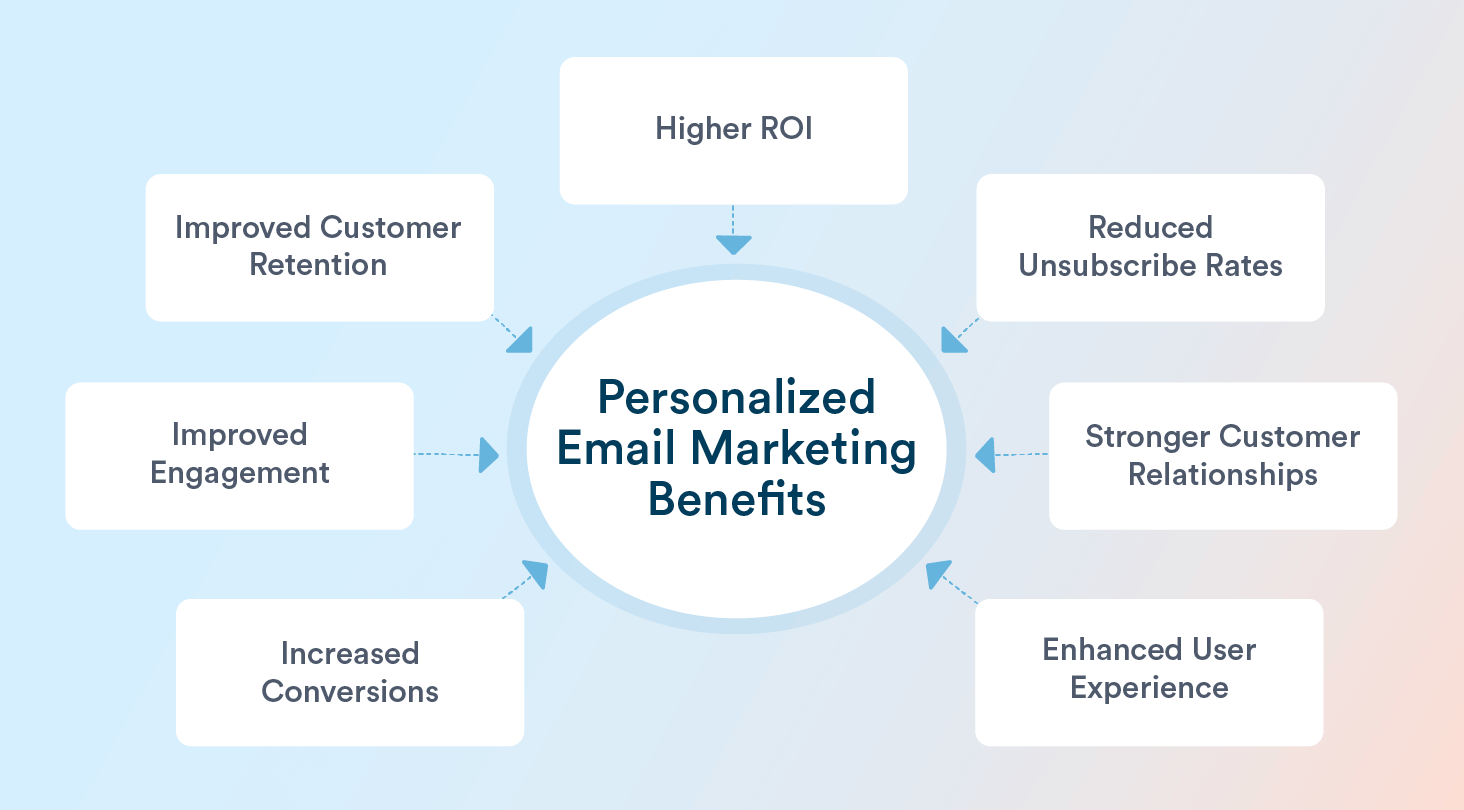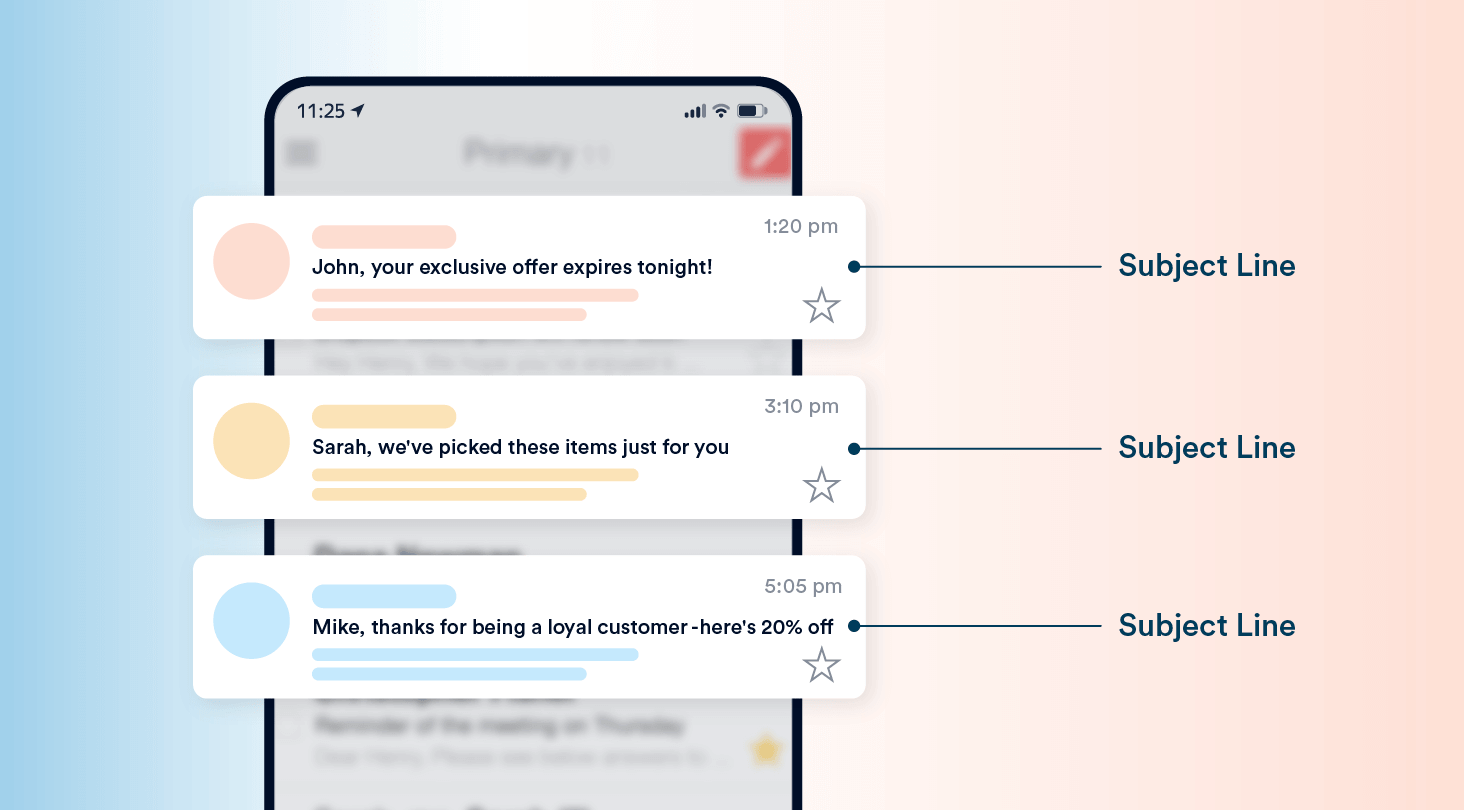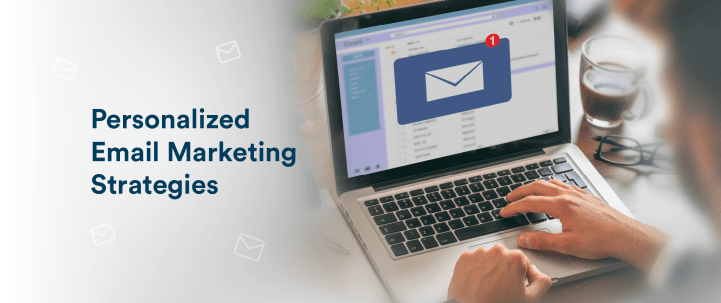Personalized email marketing is a strategy that uses customer data to deliver targeted and relevant content to their inbox. Learn about email personalization and strategies to build stronger relationships with your customers.
Your customers receive countless emails daily, which means standing out in the inbox is now more crucial than ever.
Personalized email marketing enhances customer engagement, drives conversions, and builds lasting relationships. This blog explores personalization in email marketing, its benefits, and actionable strategies to implement it effectively.
What is Personalized Email Marketing?
Personalized email marketing is a strategy that customizes email content based on the recipient’s preferences, behaviors, and interactions with a brand. Unlike generic mass emails, personalized emails aim to engage recipients by providing relevant information that meets their specific needs.
This approach includes addressing subscribers by their name, recommending products based on past purchases, or sending targeted content aligned with their interests.
What are the Benefits of Personalized Email Marketing?
The significance of personalized email marketing lies in its ability to enhance customer engagement and foster loyalty. By delivering tailored messages that resonate with recipients, you can significantly improve open rates, click-through rates, and overall conversion rates.

The benefits of personalized email marketing are manifold:
Improved Engagement
Personalized emails capture attention more effectively than generic ones.
When recipients receive content tailored to their interests, they are more likely to open and engage with the email. Personalized emails have open rates that are 82% higher than non-personalized emails. Emails with a personalized subject line are 26% more likely to be opened.
Increased Conversions
Higher engagement often translates into better conversion rates.
Personalized emails can lead to increased sales as they provide relevant offers that resonate with customers. In fact, personalized email marketing has been shown to deliver six times higher transaction rates compared to non-personalized emails. By targeting customers with products or services they’re actually interested in, you’re more likely to drive conversions.
Enhanced User Experience
By delivering content that aligns with subscribers’ preferences, you can create a more enjoyable experience for their audience.
This not only improves customer satisfaction but also encourages repeat business. Personalized emails can include tailored product recommendations, exclusive offers based on purchase history, or content that matches the subscriber’s interests. This level of customization makes the email feel less like marketing and more like a valuable service, enhancing the overall user experience.
Improved Customer Retention
Personalized email marketing can significantly boost customer retention rates. Custom email marketing helps keep your brand top-of-mind and gives customers reasons to stay engaged.
Higher ROI
Personalized email campaigns tend to generate a higher ROI compared to generic campaigns.
While the initial setup might require more time and resources, the improved performance often justifies the investment. Email marketing already has an impressive ROI, with an average return of $36 for every $1 spent, and personalization can push this even higher.
Reduced Unsubscribe Rates
When subscribers receive content that’s relevant and valuable to them, they’re less likely to unsubscribe from your email list. Personalization can help reduce unsubscribe rates by ensuring that each subscriber receives content that matches their interests and needs.
Stronger Customer Relationships
Personalization fosters a sense of connection between the brand and the customer, encouraging loyalty and repeat business.
When customers feel valued through personalized communication, they are more likely to recommend the brand to others. This word-of-mouth marketing can be incredibly powerful, with 92% of consumers trusting recommendations from friends and family over any other type of advertising.
9 Strategies to Achieve Personalization in Email Marketing
1. Understand Your Audience
To create effective personalized emails, understanding your audience deeply is essential. This goes beyond simply knowing who they are; it involves segmenting your email list based on various criteria such as demographics, purchase history, and engagement levels.
Techniques for Gathering Data:
- Surveys: Conduct surveys to gather information about customer preferences and interests. This direct feedback can provide invaluable insights into what your audience values most.
- Website Analytics: Use analytics tools to track user behavior on your website. Understanding how visitors navigate your site can help you identify their interests and tailor your emails accordingly.
- Social Media Insights: Analyze social media interactions to understand audience interests. Monitoring comments, likes, and shares can reveal what content resonates most with your followers.
A comprehensive understanding of your audience’s preferences and pain points helps you tailor your messaging to meet their needs effectively. This understanding allows you to craft more relevant content, offers, and recommendations that resonate with each segment of your audience.
For example, if you know a particular segment is interested in eco-friendly products, you can highlight those in your custom email campaigns.
2. Utilize Dynamic Content
Dynamic content allows marketers to customize email elements based on recipient data. This means that different recipients can see different content within the same email template, making the message more relevant to each individual.
Examples of Dynamic Elements:
- Product Recommendations: Suggest products based on past purchases or browsing history. For instance, if a customer frequently buys running shoes, you can showcase new arrivals in athletic gear.
- Location-Based Offers: Use location-based marketing to provide discounts or promotions specific to the recipient’s location. If you have a store opening nearby, let them know about exclusive local offers.
This level of customization enhances the relevance of your emails and increases the likelihood of conversions. Dynamic content not only engages recipients but also creates a more tailored experience that reflects their unique preferences.
3. Personalize Subject Lines
The subject line is often the first impression a recipient has of your email.
Personalizing email subject lines can significantly increase open rates; when recipients see something relevant and engaging, they are more likely to click through.

Tips for Writing Engaging Subject Lines:
- Use the recipient’s name or reference their recent interactions with your brand. For example, “John, check out our latest collection, made just for you!” immediately grabs attention.
- Incorporate urgency or exclusivity (for example, “Limited Time Offer for You, John!”). Creating a sense of urgency can prompt quicker action from recipients.
By making subject lines more relevant and engaging, you entice recipients to open your emails and explore the content within.
4. Leverage Behavioral Triggers
Behavioral triggers are actions taken by users that can prompt automated responses from your email system. These triggers allow you to send timely and relevant messages based on user behavior.
Setting Up Automated Personalized Emails:
By setting up automated personalized emails based on these triggers, you can re-engage customers who may need a little extra encouragement to complete a purchase. For instance:
- Cart Abandonment Emails: Send reminders about abandoned cart items along with incentives like discounts or free shipping.
- Follow-Up Emails: After a purchase, send thank-you notes along with recommendations for complementary products that enhance their initial purchase.
Behavioral triggers ensure that your emails are timely and contextually relevant, increasing the chances of conversion.
5. Implement A/B Testing
A/B testing is essential for optimizing personalized email campaigns. Testing different elements such as subject lines, content variations, and calls-to-action (CTAs), helps determine what resonates best with your audience.
Best Practices for A/B Testing:
- Test one variable at a time (e.g., subject line vs. content). This approach helps isolate which changes lead to improved performance.
- Analyze results based on predetermined email marketing metrics like open rates and conversion rates to gauge effectiveness accurately.
This iterative process allows you to refine your approach continually and improve overall campaign performance over time.
6. Use Email Personalization Tools
Email personalization tools help streamline personalization efforts in email marketing. An email personalization tool enables marketers to automate processes such as segmentation, dynamic content insertion, and behavioral tracking.
CleverTap’s email marketing tool helps you create personalized and interactive email experiences. Here are the key functionalities that make email personalization easy:
- Create emails effortlessly: With CleverTap’s versatile editor, you can create actionable emails, regardless of your level of expertise, using the drag-and-drop, HTML, or AMP editor. You can also make use of the fully customizable templates for the most popular use cases, and reuse and manage your templates seamlessly.
- Conduct A/B testing and optimize to achieve the best results: Conduct A/B and multivariate tests and send the best-performing email to all customers. CleverTap’s email personalization tool allows you to optimize message send times for each user in email campaigns, considering their time zone and peak activity periods.
- Personalize in real time: Contextualize messages based on user data and actions, dynamic content, and predictive recommendations to accelerate purchases.
- Convert static emails into interactive experiences: Integrate enhanced functionality and convenience into emails with AMP for email. You can engage users with interactive forms and live updates.
- Perform in-depth analysis: Assess campaign performance and discover delivery issues. You can use real-time email campaign analytics and track delivery success and reputation with deliverability reports. Spam filters and monthly reports also help you identify and fix spam root causes.
7. Create Custom Email Campaigns
Custom email campaigns tailored to specific segments of your audience can yield impressive results. Designing campaigns that address the unique needs of different customer groups—such as new subscribers or loyal customers—helps create targeted messaging that drives engagement and conversions.
Examples of Successful Custom Email Campaigns:
- Welcome Series: A series of onboarding welcome emails sent to new subscribers introducing them to your brand and offering incentives for their first purchase.
- Loyalty Rewards: Exclusive offers sent to repeat customers as a thank-you for their loyalty, reinforcing positive behavior and encouraging future purchases.
These custom approaches make recipients feel valued and understood while enhancing their connection with your brand.
8. Focus on Timing and Frequency
The timing and frequency of your emails play a crucial role in their effectiveness. Sending personalized emails at optimal times based on audience behavior can significantly impact open rates and engagement levels.
Strategies for Determining Optimal Send Times:
- Analyze past campaign data to identify when recipients are most active; this helps pinpoint ideal sending times.
- Use A/B testing to experiment with different sending times across segments to determine what works best for each group.
By sending emails at the right time, you increase the chances of them being opened and acted upon while respecting your audience’s time preferences.
9. Analyze and Optimize Performance
To ensure ongoing success with personalized email marketing strategy, it’s vital to track key performance metrics such as open rates, click-through rates (CTR), and conversion rates.
Techniques for Using Analytics:
- Use analytics tools to monitor campaign performance over time; this helps identify trends in engagement.
- Adjust strategies based on insights gained from data analysis; continuously refining approaches ensures that personalization remains effective as audience preferences evolve.
This continuous improvement process helps refine personalization strategies over time, ensuring that they remain relevant and impactful in driving engagement and conversions.
These strategies are effectively tailored for marketers, so you can create personalized email campaigns that not only engage recipients but also drive meaningful results for your businesses.
Custom email marketing is an ongoing journey that helps foster stronger relationships with audiences while achieving higher ROI through tailored communication strategies.
Personalized Email Marketing Examples
Here are some personalized email marketing examples that you can use to dictate your email campaign personalization strategies.
1. E-commerce Recommendations
An online retailer may use personalized email marketing to send tailored product recommendations based on previous purchases and browsing behavior.

For instance, if a customer frequently buys running gear, the retailer will send emails highlighting new arrivals in athletic apparel or accessories that complement their past purchases, maybe along with exclusive discounts as well. This strategy not only increases engagement but also drives repeat sales, as customers are more likely to purchase items that align with their interests.
2. Birthday Discounts
Many brands enhance customer loyalty by sending automated birthday emails that offer exclusive discounts or freebies to celebrate customers’ special days.
For example, a beauty brand might send a personalized email with a 20% discount on any purchase during the recipient’s birthday month. This personal touch makes customers feel valued and encourages them to make a purchase.
3. Re-engagement Campaigns
Companies often target inactive subscribers with tailored content designed to reignite their interest in the brand.
For instance, a streaming service might send an email to users who haven’t logged in for a while, featuring personalized content recommendations based on their viewing history. This could include new shows or movies similar to what they previously enjoyed.
By offering exclusive discounts or highlighting new features using a custom email marketing strategy, brands can effectively re-engage these subscribers and encourage them to return.
4. Personalized Product Launch Announcements
A fashion retailer might use custom email marketing to announce new product launches tailored to individual customer preferences.
For example, if a customer has previously shown interest in sustainable fashion, the retailer could send an email highlighting their latest eco-friendly collection. By aligning product launches with customer interests, brands can create excitement and drive immediate sales.
5. Customized Follow-Up Emails
After a purchase, brands can send customized follow-up emails thanking customers for their order and suggesting complementary products.
For instance, an electronics retailer might send an email after a customer buys a camera, recommending accessories like lenses or tripods based on the purchase. This strategy not only enhances the customer experience but also encourages additional purchases through cross-selling.
These examples highlight how personalization can enhance customer experiences while driving business results. By leveraging data and insights to create tailored communications, brands can foster deeper connections with their audience and improve overall engagement and conversion rates.
Personalization In Email Marketing Is No Longer Just An Option
Custom email marketing is a necessity for marketers to significantly enhance engagement and drive higher ROI.
As consumers increasingly expect tailored experiences from brands they interact with, embracing custom email marketing will not only improve customer satisfaction but also foster long-term loyalty and growth for businesses. Start implementing these strategies today to elevate your email marketing efforts!
Agnishwar Banerjee 
Leads content and digital marketing.Expert in SaaS sales, marketing and GTM strategies.
Free Customer Engagement Guides
Join our newsletter for actionable tips and proven strategies to grow your business and engage your customers.














































